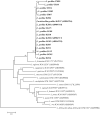Characteristics of Gorilla-Specific Lactobacillus Isolated from Captive and Wild Gorillas
- PMID: 30110987
- PMCID: PMC6165273
- DOI: 10.3390/microorganisms6030086
Characteristics of Gorilla-Specific Lactobacillus Isolated from Captive and Wild Gorillas
Abstract
Lactic acid bacteria (LAB) reside in a wide range of mammals, such as autochthonous intestinal bacteria. In this paper, we present the phenotypic and phylogenetic characteristics of gorilla-specific LAB. Lactobacillus gorillae-previously isolated from the wild and captive western lowland gorillas (Gorilla gorilla gorilla)-were successfully isolated from wild mountain gorillas (Gorilla gorilla beringei) in addition to other captive and wild western lowland gorillas. The strains from wild gorillas could ferment D-xylose, arbutine, cellobiose, and trehalose better than those from captive gorillas. By contrast, tolerance to NaCl was higher in isolates from captive gorillas than in those from wild gorillas. This tendency may have been induced by regular foods in zoos, which contain sufficient amount of salts but less amount of indigestible fiber and plant secondary metabolites compared to foods in the wild. All strains of L. gorillae showed inhibitory activities to enteric pathogenic bacteria; however, the activity was significantly higher for strains from wild gorillas than for those from captive gorillas. This may have been induced by the captive condition with routine veterinary intervention. Since L. gorillae can grow in the gastrointestinal tract of gorillas in captivity, the strains from wild mountain gorillas are potential probiotics for gorillas under captive conditions.
Keywords: Lactobacillus gorillae; antipathogenic infection; mountain gorilla; phenotypic characteristic; phylogeny; western lowland gorilla.
Conflict of interest statement
The authors declare no conflict of interest.
Figures


References
LinkOut - more resources
Full Text Sources
Other Literature Sources
Research Materials
Miscellaneous

